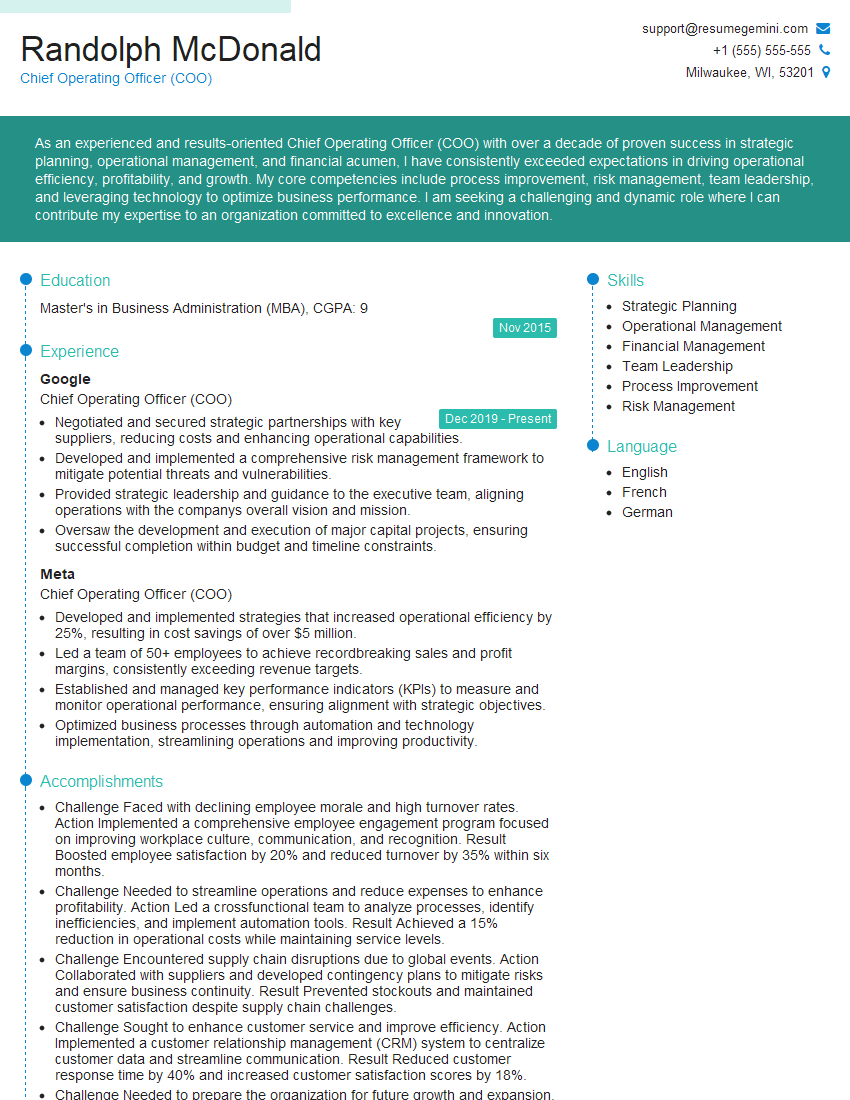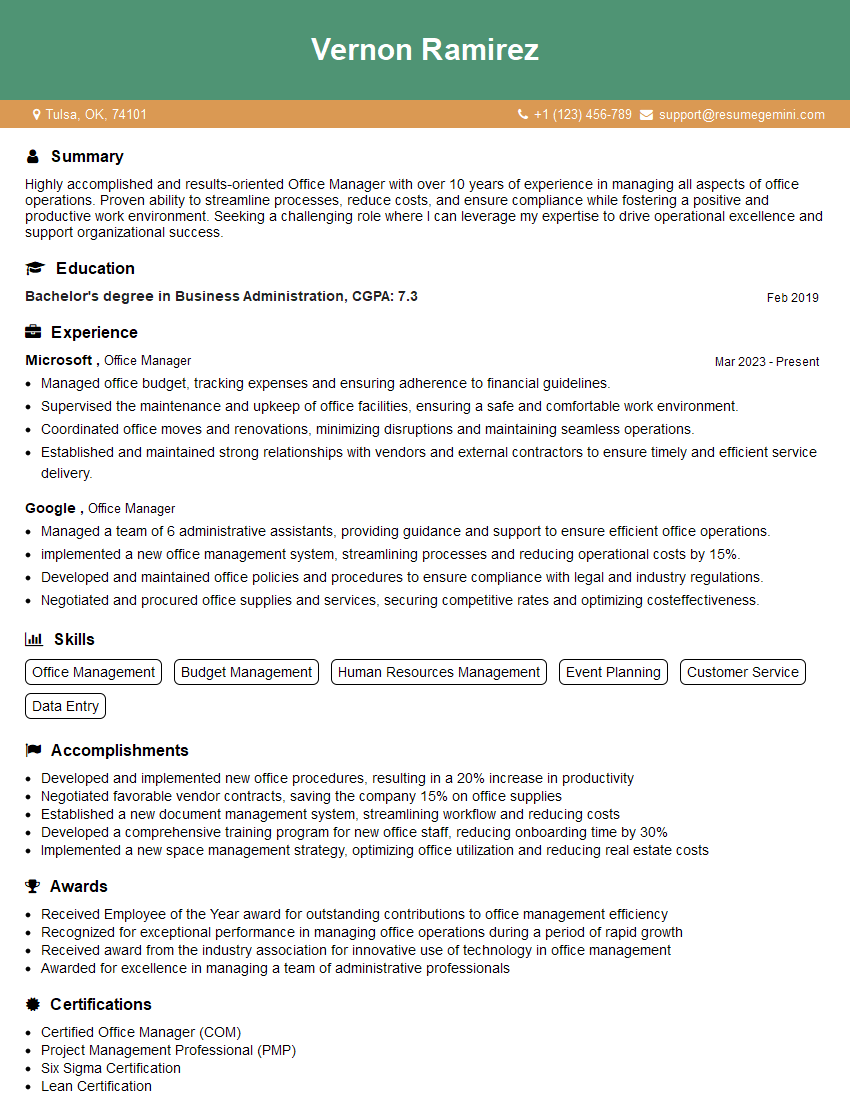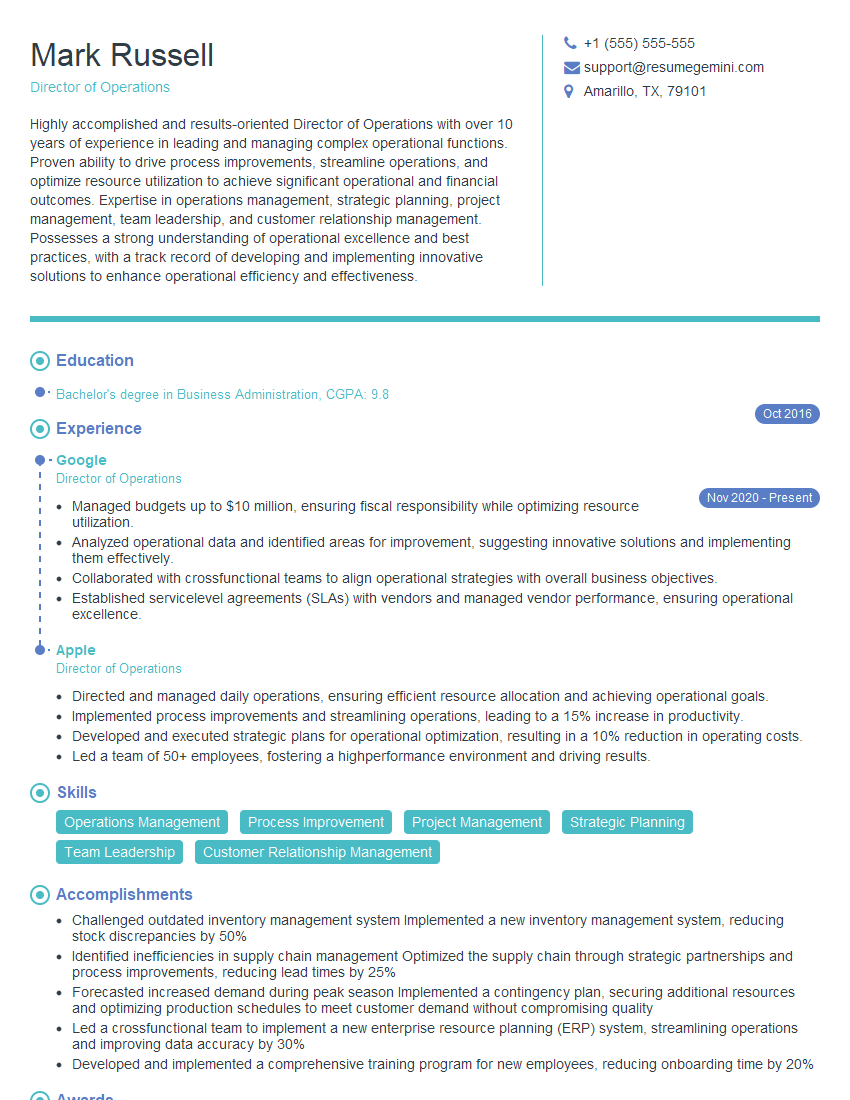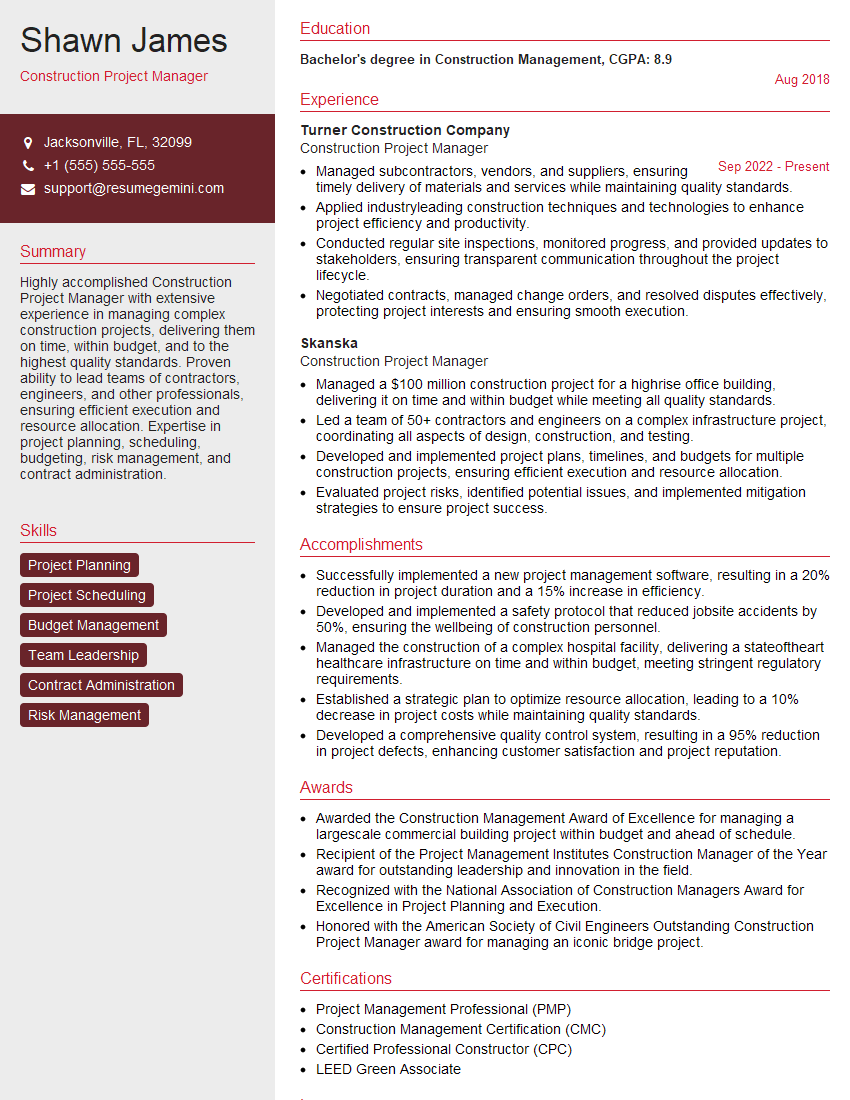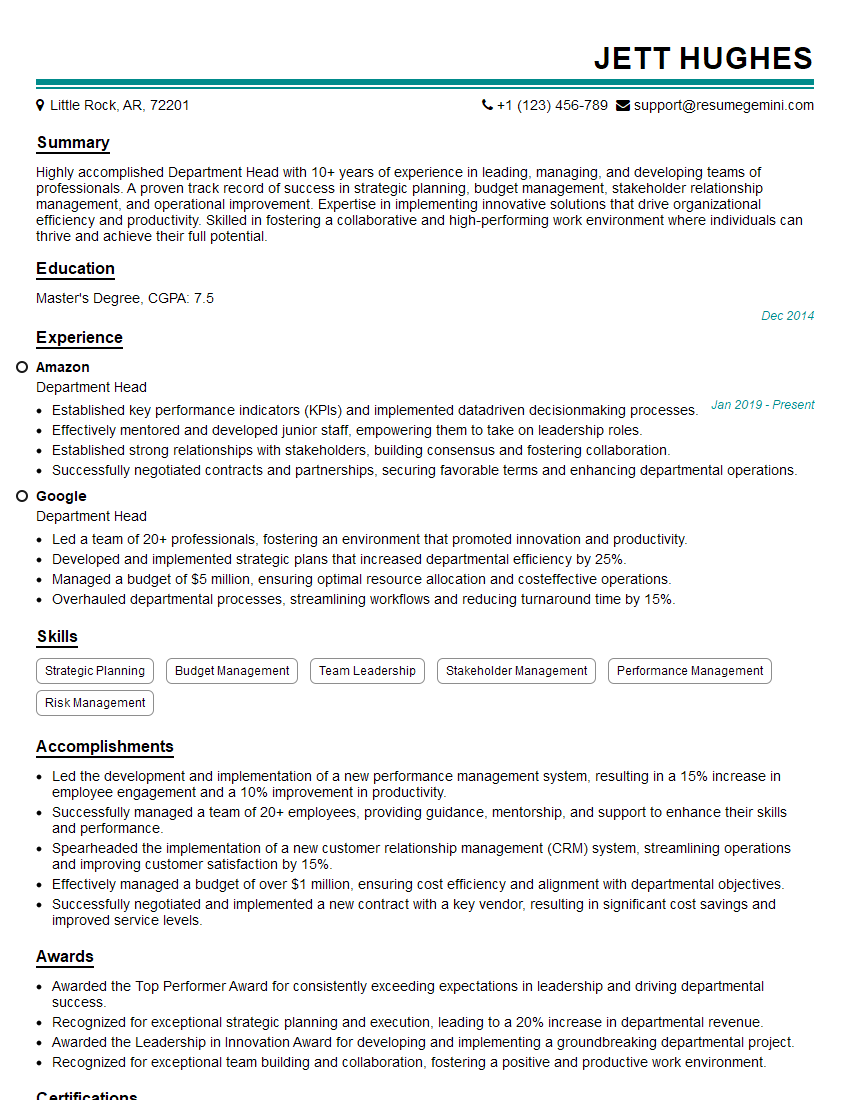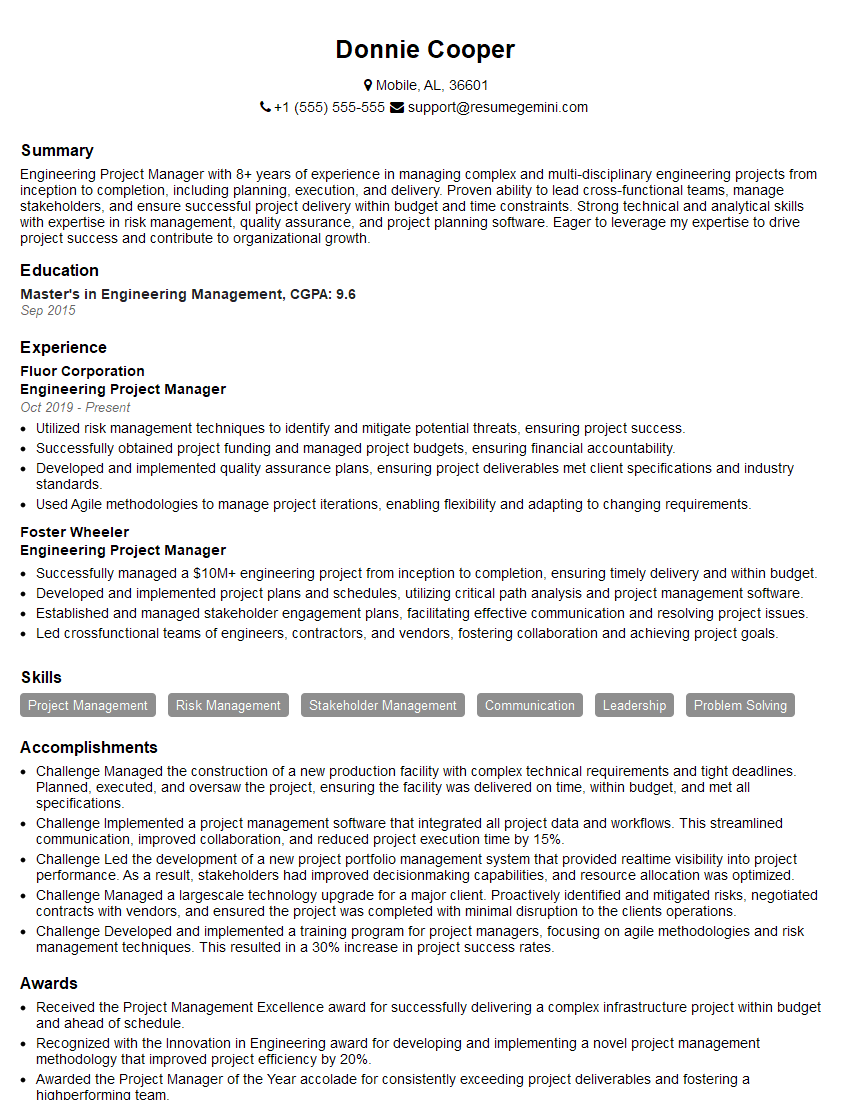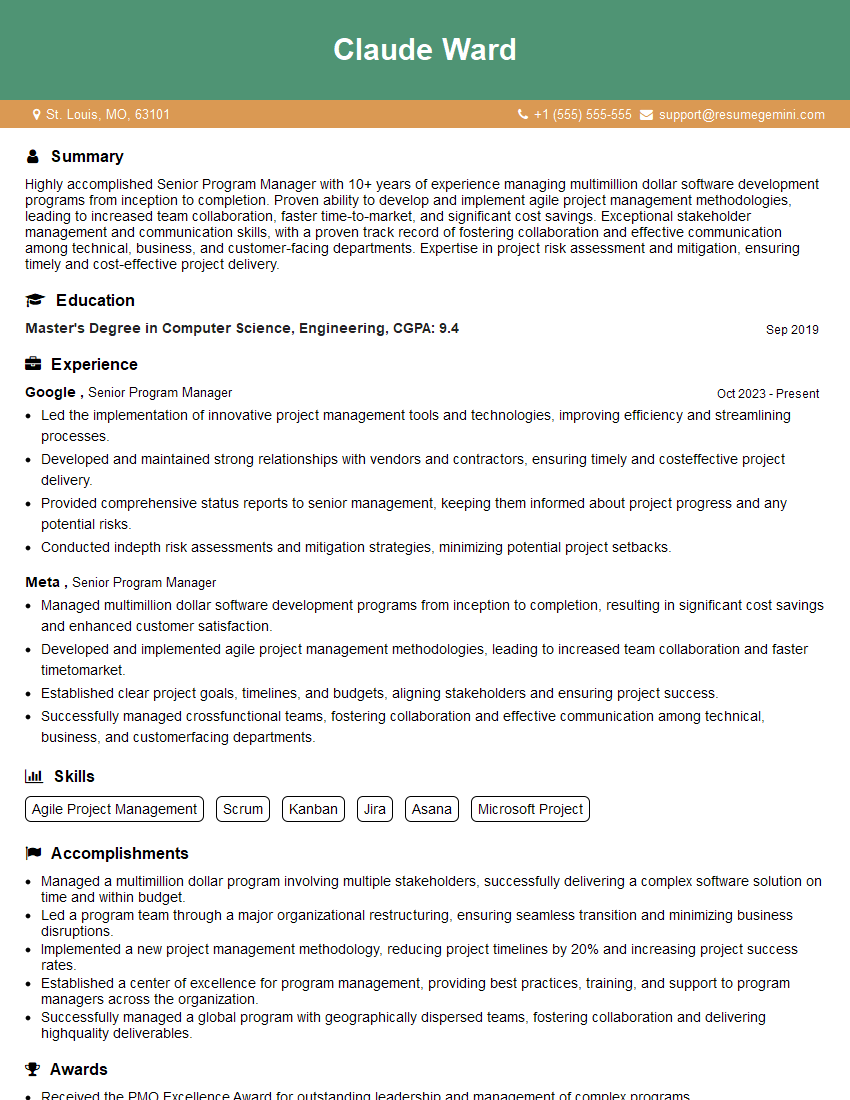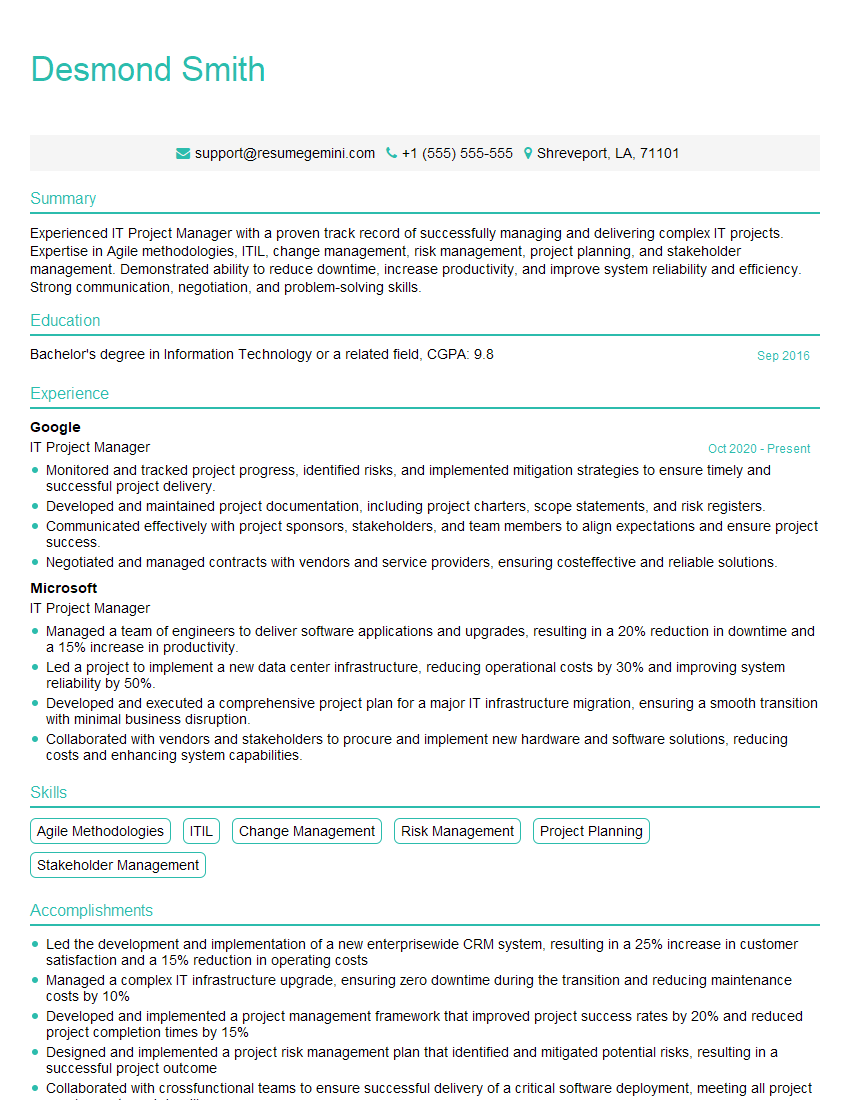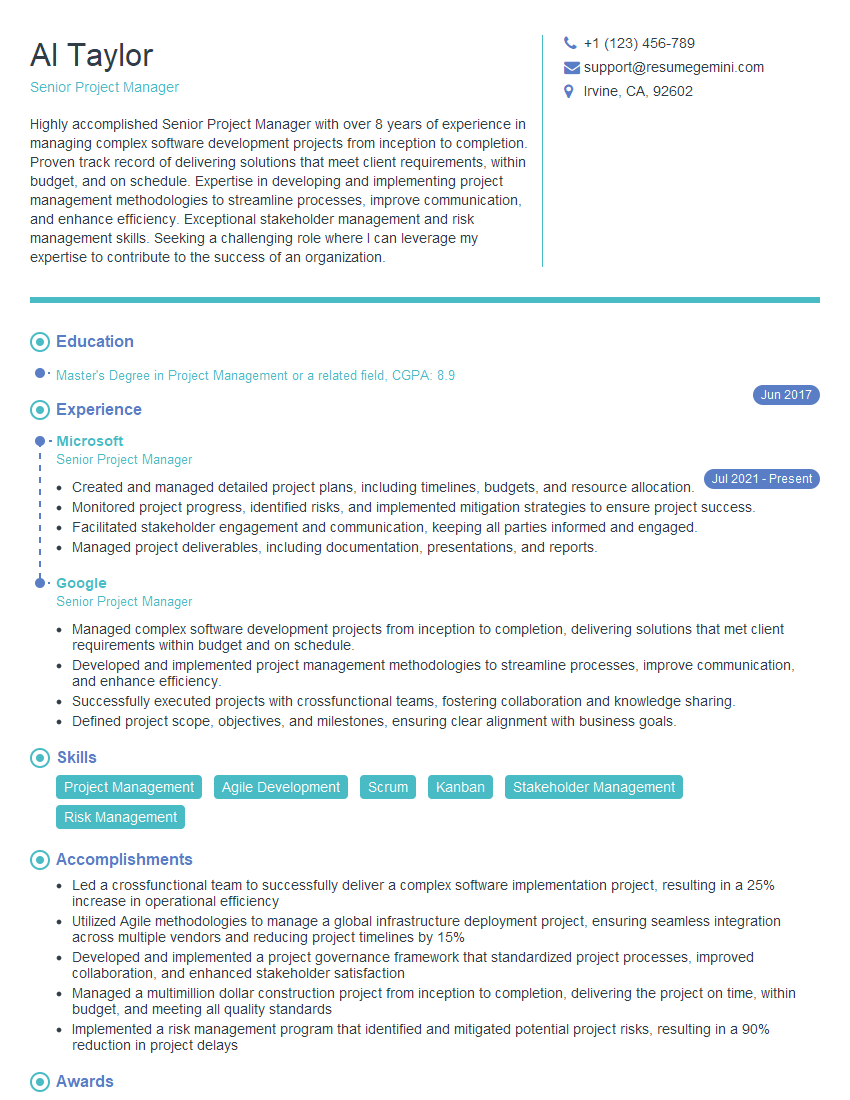Every successful interview starts with knowing what to expect. In this blog, we’ll take you through the top Ability to prioritize tasks and manage multiple projects interview questions, breaking them down with expert tips to help you deliver impactful answers. Step into your next interview fully prepared and ready to succeed.
Questions Asked in Ability to prioritize tasks and manage multiple projects Interview
Q 1. Describe your approach to prioritizing tasks when faced with competing deadlines.
Prioritizing tasks with competing deadlines requires a structured approach. I utilize a combination of methods, starting with a clear understanding of each task’s urgency and importance. I employ a matrix, often visualized as a quadrant, that categorizes tasks based on urgency (deadline proximity) and importance (impact on overall goals).
- Urgent and Important: These are immediate priorities, requiring immediate attention. Think of a critical bug fix with an imminent release deadline.
- Important but Not Urgent: These tasks are crucial for long-term success but don’t have immediate deadlines. This might include strategic planning or developing a new training program.
- Urgent but Not Important: These tasks need immediate attention, but their impact is limited. An example might be responding to a non-critical customer email.
- Neither Urgent nor Important: These are often delegated or postponed. They might include less-critical administrative tasks.
After categorization, I prioritize tasks within each quadrant, using techniques like the MoSCoW method (Must have, Should have, Could have, Won’t have) to further refine the order. This ensures that critical path items are always addressed first. Regular review and adjustment are key to maintaining this prioritization throughout the project lifecycle.
Q 2. How do you handle unexpected interruptions or changes in project priorities?
Unexpected interruptions are inevitable. My approach involves a combination of proactive measures and reactive adjustments. Proactively, I maintain open communication with stakeholders and build buffer time into my schedule to accommodate unforeseen events. When interruptions do occur, I assess their impact using the same urgency/importance matrix mentioned previously.
If the interruption is truly urgent and important, I re-prioritize immediately, adjusting the schedule and communicating changes to the team. If it’s less urgent, I schedule it for later, using a task management system to track it. The key is to remain flexible, adaptable, and transparent in communication throughout the process. I often utilize a system of quick prioritization questions: Does this impact a deadline? Does this need immediate attention? Will ignoring it cause more problems later? These questions help me make quick, informed decisions.
Q 3. What tools or techniques do you use to manage multiple projects simultaneously?
Managing multiple projects concurrently requires robust tools and techniques. I leverage project management software like Asana, Jira, or Monday.com to track tasks, deadlines, and progress across all projects. These tools allow for task assignment, progress tracking, and communication within teams.
Beyond software, I employ time-blocking techniques to allocate specific time slots to each project. This prevents task switching and maximizes focus. Regular project status meetings help maintain visibility and ensure effective coordination between teams working on different projects. Finally, consistent review of my project portfolio helps me identify and address potential bottlenecks or resource conflicts proactively.
Q 4. Explain your method for delegating tasks effectively within a project.
Effective delegation is crucial for efficient project management. My approach involves carefully considering the skills and expertise of team members. I assign tasks based on individual strengths, ensuring that each person receives tasks aligned with their abilities and experience. This maximizes efficiency and job satisfaction.
Before delegating, I provide clear instructions, setting well-defined expectations, including deadlines and quality standards. I also ensure open communication channels, making myself available to answer questions and offer support. Regular check-ins throughout the process ensure that tasks are progressing as planned and allow for timely adjustments if needed. Providing regular feedback, both positive and constructive, is crucial for motivating the team and ensuring consistent high-quality work.
Q 5. How do you determine the critical path in a project and allocate resources accordingly?
Identifying the critical path, the sequence of tasks that determine the shortest possible project duration, is critical for resource allocation. I use Gantt charts or project management software to visually represent task dependencies and durations. This allows me to identify the tasks that directly impact the project’s overall timeline.
Once the critical path is identified, I allocate resources strategically, focusing on the tasks that lie on this path. This often involves prioritizing skilled personnel and necessary resources to these critical tasks to minimize delays. For tasks not on the critical path, some flexibility in resource allocation is possible, allowing for potential re-allocation if needed on the critical path. This ensures that the project stays on schedule and within budget.
Q 6. Describe a time you had to re-prioritize tasks due to unforeseen circumstances. What was the outcome?
In a previous project, we were developing a new software application with a tight deadline. A critical third-party component experienced unexpected delays, pushing back our planned integration timeline. This necessitated immediate re-prioritization.
We held an emergency team meeting to assess the impact of the delay and identify alternative solutions. We decided to temporarily deprioritize some less critical features to focus on integrating the remaining components and meeting the core functionalities’ deadline. This involved open communication with stakeholders to manage expectations. The outcome was a successful launch, albeit with reduced functionality in the initial release. The deprioritized features were integrated in subsequent releases.
Q 7. How do you measure the success of your project prioritization strategies?
Measuring the success of project prioritization strategies involves assessing multiple key performance indicators (KPIs). On-time and on-budget delivery is a primary metric. We also evaluate the achievement of key project milestones.
Qualitative measures include assessing stakeholder satisfaction with the project outcome and the overall efficiency of the process. This includes gathering feedback through surveys or meetings. Analyzing the time spent on various tasks and comparing it to the initial estimations helps to assess the effectiveness of prioritization in resource allocation. Regular project reviews provide opportunities to identify areas for improvement in our prioritization methods.
Q 8. How do you communicate project priorities and changes to your team?
Communicating project priorities and changes effectively is crucial for team alignment and success. My approach involves a multi-faceted strategy focusing on clarity, consistency, and accessibility.
Regular Team Meetings: I hold regular stand-up meetings (daily or weekly depending on project complexity) to provide updates, discuss roadblocks, and confirm everyone understands the priorities. These meetings are not just for information dissemination; they’re designed to foster open dialogue and address any concerns proactively.
Visual Project Management Tools: I leverage visual tools like Kanban boards (physical or digital) to represent the project status and priorities clearly. This provides a shared understanding of the workflow, task dependencies, and the current critical path. For example, in a recent marketing campaign, using a Trello board allowed the team to easily see which tasks were blocked and where support was needed.
Clear and Concise Communication: When changes occur, I communicate them promptly and transparently. This includes clearly explaining the rationale behind the change, its impact on the project timeline, and the necessary adjustments to the team’s work. I utilize multiple channels – emails, instant messaging, and project management software – to ensure everyone receives the message.
Documented Changes: All changes to priorities, deadlines, or project scope are documented formally (e.g., updated project plans, meeting minutes) and easily accessible to the entire team. This ensures consistency and allows team members to easily refer back to any changes made.
Q 9. What is your experience with project management methodologies (e.g., Agile, Waterfall)?
I have extensive experience working with both Agile and Waterfall methodologies, understanding their strengths and limitations. My choice of methodology is always tailored to the specific project requirements and team dynamics.
Waterfall: I find Waterfall best suited for projects with well-defined requirements, minimal expected changes, and where a sequential approach is advantageous. In past projects, I successfully managed large-scale software deployments using this methodology, focusing on clear documentation and meticulous planning.
Agile (Scrum, Kanban): For projects with evolving requirements, frequent changes, and a need for rapid iteration, Agile methodologies are my preferred choice. I’ve successfully managed numerous projects using Scrum, embracing iterative development, sprint reviews, and daily stand-up meetings. For instance, I led a team developing a mobile application using Scrum, resulting in a quicker time to market and increased stakeholder satisfaction. My experience with Kanban has been particularly valuable in managing ongoing tasks and maintenance projects.
Hybrid Approaches: Often, the most effective approach is a hybrid, combining aspects of both methodologies. For example, I may use Agile principles for development sprints within the overall structure of a Waterfall project lifecycle. This provides the flexibility of Agile while maintaining the structure and predictability of Waterfall.
Q 10. How do you identify and mitigate potential risks that could impact project timelines?
Proactive risk management is essential for successful project delivery. My approach involves a systematic process of identifying, assessing, and mitigating potential risks.
Risk Identification: This involves brainstorming sessions with the team, reviewing project documentation, and consulting with stakeholders to identify potential issues. Techniques like SWOT analysis (Strengths, Weaknesses, Opportunities, Threats) and risk register creation are invaluable tools in this phase.
Risk Assessment: Once risks are identified, I assess their likelihood and potential impact on the project using a probability and impact matrix. This helps prioritize which risks need immediate attention.
Risk Mitigation: For high-priority risks, I develop mitigation strategies, which might include contingency plans, risk transfer (e.g., insurance), risk avoidance (e.g., changing the project scope), or risk reduction (e.g., implementing stricter quality control). For instance, in a project facing potential supply chain delays, we mitigated this risk by securing alternative suppliers well in advance.
Risk Monitoring: Risks are not static; they evolve throughout the project lifecycle. Regular monitoring and reporting help identify new risks and track the effectiveness of mitigation strategies.
Q 11. How do you handle conflicts between project deadlines and resource availability?
Balancing project deadlines and resource availability often requires careful prioritization and negotiation.
Prioritization: I use prioritization techniques like MoSCoW (Must have, Should have, Could have, Won’t have) to focus on the most critical tasks and deliverables. This helps determine which tasks can be delayed or adjusted without significantly compromising project success.
Resource Allocation: I work closely with team members and stakeholders to understand their capacity and availability. This may involve re-allocating tasks, adjusting timelines, or seeking additional resources (e.g., outsourcing, hiring temporary staff).
Negotiation and Collaboration: When conflicts arise, I facilitate open communication between team members and stakeholders to find mutually acceptable solutions. This might involve adjusting deadlines, re-prioritizing tasks, or negotiating compromises.
Change Management: Any changes to deadlines or resource allocation are communicated clearly and documented to maintain transparency and accountability. For example, in a project where a key team member was unexpectedly unavailable, I adjusted the project schedule and reassigned tasks, keeping all stakeholders informed of the revised timeline.
Q 12. What strategies do you use to stay organized and manage your workload effectively?
Staying organized and managing my workload effectively requires a combination of tools, techniques, and habits.
Time Blocking: I allocate specific time blocks for different tasks and projects, ensuring focused work periods. This approach minimizes context switching and improves productivity.
Task Management Systems: I use task management software (like Todoist or Asana) to track all my tasks and projects, setting deadlines and prioritizing them based on urgency and importance.
Prioritization Matrices: Using methods such as Eisenhower Matrix (urgent/important), I can effectively sort tasks and focus my attention on high-impact activities first.
Regular Review and Adjustment: I regularly review my schedule and task list, adjusting priorities and deadlines as needed based on changing circumstances or unexpected events. This proactive approach ensures I remain on track and prevent overwhelm.
Delegation: When possible, I delegate tasks to appropriate team members, ensuring that they have the necessary resources and support.
Q 13. Describe your experience using project management software (e.g., Asana, Jira, Trello).
I have extensive experience using various project management software, including Asana, Jira, and Trello. My choice of software depends on the project’s specific needs and team preferences.
Asana: Asana is a versatile tool well-suited for managing tasks, projects, and teams. I have used it for projects requiring strong collaboration and communication, particularly within cross-functional teams. Its features for task assignment, progress tracking, and communication are very effective.
Jira: I use Jira primarily for agile software development projects. Its workflow customization and issue tracking capabilities are invaluable for managing sprints, bugs, and feature requests.
Trello: Trello’s Kanban-style boards are ideal for visualizing workflows and tracking progress. I’ve found it especially useful for smaller projects or when working with teams who prefer a visual approach to project management.
Software Proficiency: My proficiency extends beyond simply using these tools; I understand their underlying principles and adapt them to specific project needs, tailoring workflows and customizations to improve team efficiency.
Q 14. How do you build and maintain strong relationships with stakeholders in multiple projects?
Building and maintaining strong relationships with stakeholders across multiple projects is crucial for success. My strategy is based on clear communication, proactive engagement, and mutual respect.
Regular Communication: I keep stakeholders informed about project progress, challenges, and any changes that may affect them. This includes regular updates, both written and verbal, tailored to each stakeholder’s needs and communication preferences.
Proactive Engagement: I proactively solicit feedback and address concerns from stakeholders, ensuring they feel heard and valued. I use various communication channels – emails, meetings, presentations – to engage stakeholders effectively.
Relationship Building: I strive to build trust and rapport with stakeholders through consistent communication, transparency, and a collaborative approach. I make an effort to understand their priorities and concerns, incorporating their input into project decisions when appropriate.
Conflict Resolution: I use effective conflict resolution strategies to address any disagreements or conflicts constructively, focusing on finding mutually acceptable solutions.
Documentation: Maintaining detailed records of communications, decisions, and agreements is essential for transparency and accountability. This ensures all stakeholders are on the same page and minimizes misunderstandings.
Q 15. How do you handle situations where a project is behind schedule or over budget?
When a project falls behind schedule or exceeds budget, my immediate response is a controlled assessment, not panic. I initiate a structured process involving several key steps. First, I convene a meeting with the project team to collaboratively pinpoint the root causes of the delays or cost overruns. This often involves reviewing the project timeline, budget allocation, and any unforeseen obstacles encountered. For example, if a software development project is behind, we’d examine if there were underestimated development complexities, unanticipated bugs, or resource constraints. Once the root causes are identified, we develop a corrective action plan. This might involve reallocating resources, adjusting the timeline (perhaps prioritizing critical tasks), or negotiating with stakeholders to adjust the scope. Open and honest communication with stakeholders throughout this process is crucial to manage expectations and secure buy-in for any necessary changes. For instance, if budget overruns are unavoidable, I would transparently explain the reasons and propose adjusted budget projections to stakeholders. This proactive approach helps avoid future conflicts and maintain trust.
Career Expert Tips:
- Ace those interviews! Prepare effectively by reviewing the Top 50 Most Common Interview Questions on ResumeGemini.
- Navigate your job search with confidence! Explore a wide range of Career Tips on ResumeGemini. Learn about common challenges and recommendations to overcome them.
- Craft the perfect resume! Master the Art of Resume Writing with ResumeGemini’s guide. Showcase your unique qualifications and achievements effectively.
- Don’t miss out on holiday savings! Build your dream resume with ResumeGemini’s ATS optimized templates.
Q 16. Describe your approach to risk assessment and mitigation in project management.
Risk assessment and mitigation are integral to my project management philosophy. I employ a systematic approach that begins with proactive identification of potential risks. This involves brainstorming sessions with the project team, reviewing past project experiences, and using risk assessment tools and methodologies. Think of it as a preemptive strike against potential problems. For instance, in a marketing campaign project, we might identify risks such as unexpected changes in market trends, competitor actions, or negative PR. Once identified, we evaluate each risk’s probability and potential impact. Then, we develop mitigation strategies for high-impact risks. This might include developing contingency plans (alternative solutions), allocating buffer time in the schedule, or securing additional resources. For example, for the marketing campaign risk of negative PR, a mitigation strategy could involve preparing a crisis communication plan. Continuous monitoring is key; we track identified risks throughout the project lifecycle, adjusting mitigation strategies as needed. Regular risk reviews ensure that we stay ahead of potential problems.
Q 17. What metrics do you use to track project progress and identify potential issues?
Tracking project progress and spotting potential issues requires a multi-faceted approach relying on various key performance indicators (KPIs). These metrics provide a holistic view of project health. I typically monitor:
- Schedule adherence: Tracking actual progress against planned milestones, using tools like Gantt charts to visualize the schedule and identify delays.
- Budget adherence: Monitoring actual spending versus the allocated budget, regularly reviewing expense reports.
- Resource utilization: Tracking the availability and productivity of team members to ensure optimal resource allocation.
- Quality metrics: Measuring the quality of deliverables through regular testing and feedback loops. This could include defect rates in software development or client satisfaction surveys in a marketing project.
- Risk register updates: Regularly monitoring the status of identified risks and the effectiveness of mitigation strategies.
By consistently monitoring these metrics, using dashboards or project management software, I can identify potential problems early, allowing for proactive intervention. For example, a sudden increase in defect rates might signal a problem with the development process, prompting us to review the coding standards or testing procedures.
Q 18. How do you ensure that all projects adhere to organizational standards and guidelines?
Ensuring adherence to organizational standards and guidelines is paramount. I achieve this through a combination of proactive measures and continuous monitoring. First, I ensure that the project team is thoroughly briefed on all relevant standards and guidelines at the project initiation phase. This might include documentation standards, coding conventions, security protocols, or regulatory compliance requirements. I then integrate these standards into the project plan and processes. This means using approved templates for documentation, adhering to specific software development methodologies, and implementing appropriate security measures throughout the project lifecycle. Regular audits and reviews ensure continuous compliance. We use checklists and automated tools where possible to identify deviations from standards. For instance, in a software development project, static code analysis tools can automatically detect violations of coding standards. Finally, I incorporate compliance training and continuous improvement practices to enhance our adherence to organizational standards and address any identified gaps.
Q 19. How do you balance short-term priorities with long-term strategic goals?
Balancing short-term priorities with long-term strategic goals requires a strategic and organized approach. I use a prioritization matrix that considers both the urgency and importance of tasks. Urgency is defined by immediate deadlines or critical needs, while importance is aligned with the organization’s long-term goals. Items high in both urgency and importance are addressed immediately. Those high in importance but low in urgency are scheduled for later, but still remain a focus. Tasks low in both are delegated or potentially eliminated. Furthermore, I use project roadmapping to visualize the alignment between short-term actions and long-term strategic objectives. This allows me to ensure that daily tasks directly contribute to the overall strategic goals. For example, if a long-term goal is market expansion, short-term priorities might involve completing market research, developing a marketing strategy, and securing funding.
Q 20. How do you handle pressure and maintain productivity when working on multiple projects?
Managing multiple projects while under pressure requires a structured approach and strong time management skills. I rely heavily on effective prioritization techniques, utilizing tools like Eisenhower Matrix (urgent/important) to allocate my time effectively. I also leverage time blocking techniques, scheduling specific blocks of time for each project based on its priority and urgency. Regular breaks and mindfulness exercises help prevent burnout. I also practice clear and concise communication with stakeholders to proactively manage expectations and avoid unnecessary stress. Delegation is a vital skill; I empower team members to handle tasks within their expertise, freeing up my time for higher-level strategic decisions. Finally, effective communication within the team is crucial. Regular team meetings and progress updates ensure that everyone is on the same page and support each other. I view this pressure as a challenge and approach it methodically.
Q 21. How do you adapt your approach to prioritization based on the type of project?
My prioritization approach adapts depending on the project type. For example:
- Time-critical projects: I use a more agile approach, focusing on rapid iteration and delivering incremental value. Prioritization is driven by deadlines and critical path activities. Here, Kanban boards are incredibly effective.
- Complex projects: I employ a more structured approach, using critical path analysis and work breakdown structures to identify dependencies and prioritize tasks accordingly. Gantt charts are helpful in these scenarios.
- Strategic projects: Prioritization aligns with long-term strategic objectives. Value-driven prioritization techniques are employed, focusing on tasks that deliver the greatest impact towards overarching goals. Roadmapping helps here.
Understanding the unique characteristics of each project allows me to select the appropriate prioritization method, ensuring optimal resource allocation and timely completion.
Q 22. What are some common mistakes you see people make when managing multiple projects?
One of the biggest mistakes in managing multiple projects is a lack of clear prioritization. This often stems from poor planning and a failure to define project goals and dependencies. People tend to get caught up in the urgency of immediate tasks, neglecting strategic long-term goals. Another common mistake is inadequate resource allocation – spreading themselves too thin across too many projects, leading to burnout and decreased quality of work. Finally, ineffective communication contributes to project failures. Teams working on intertwined projects need a centralized system for updates and coordination to avoid duplicated effort or conflicting priorities.
- Example: Imagine a marketing team launching three campaigns simultaneously. Without a well-defined prioritization strategy, they might spend equal time on each, hindering the success of all three. A better approach would be to prioritize based on potential ROI or market impact, allocating resources accordingly.
Q 23. How do you define success in a project management context?
Project success, in my view, is multifaceted. It’s not just about delivering a project on time and within budget; it’s about delivering value. This means achieving the project’s objectives, meeting stakeholder expectations, and ultimately contributing to the organization’s overall goals. Success also hinges on building a strong, collaborative team, fostering knowledge sharing and growth, and ensuring the project leaves a positive and lasting impact. Simply checking off boxes isn’t enough; the results must align with the intended purpose and deliver tangible benefits.
- Example: Launching a new product on time and under budget is a good start. However, if the product doesn’t sell well or fail to meet its intended market needs, it’s not a successful project, regardless of the timeline and budget adherence.
Q 24. Explain your understanding of the Pareto principle (80/20 rule) in project management.
The Pareto principle, or 80/20 rule, suggests that 80% of the results come from 20% of the effort. In project management, this means identifying the 20% of tasks that yield the most significant impact. By focusing on these high-impact activities, we can maximize productivity and achieve the most critical objectives. This requires careful analysis to determine which tasks are truly essential and which can be delegated, deferred, or even eliminated. It’s not about neglecting the remaining 80%, but about strategically allocating resources to maximize returns.
- Example: In software development, 20% of the code might contain 80% of the bugs. Identifying and fixing these critical bugs first significantly improves the overall stability and usability of the software.
Q 25. How do you utilize data and analytics to inform your prioritization decisions?
Data and analytics are crucial for informed prioritization. I use various tools and techniques to gather and analyze relevant data. This could include project timelines, resource utilization reports, risk assessments, stakeholder feedback, and even market research. I utilize this data to identify bottlenecks, assess potential risks, and understand the dependencies between tasks. This allows me to make data-driven decisions, ensuring resources are allocated to the highest-value activities and mitigating potential problems proactively.
- Example: Using a project management software, I can track the time spent on various tasks and identify which tasks consistently take longer than estimated. This insight informs future planning and resource allocation.
Q 26. How do you ensure effective communication across multiple projects and teams?
Effective communication is paramount when juggling multiple projects and teams. I establish clear communication channels, using a combination of regular meetings, project management software, email updates, and even instant messaging platforms. I ensure that all relevant stakeholders have access to the information they need and that communication is consistent and transparent across all projects. Regular status reports and progress updates help maintain transparency and alignment. To avoid information overload, I tailor communication to the audience, delivering the right information to the right people at the right time.
- Example: Using a project management tool with a shared dashboard provides a single source of truth, where all team members can access the latest project status and relevant documentation.
Q 27. Describe a time you had to make a difficult decision about prioritizing tasks. What was the rationale behind your decision?
In a previous role, we faced a critical decision: whether to prioritize developing a new feature for our flagship product or focus on fixing a significant bug that was impacting a large number of users. The new feature was a strategic initiative to enhance market competitiveness, while fixing the bug was crucial for user satisfaction and brand reputation. After analyzing user feedback, the severity of the bug, and its potential financial impact, we prioritized fixing the bug. Our rationale was simple: addressing the urgent issue prevented further user churn and maintained customer loyalty, laying a strong foundation for the successful launch of the new feature later.
Q 28. How do you motivate and support your team members when faced with multiple competing priorities?
Motivating and supporting a team under pressure requires empathy, clear communication, and a proactive approach. I start by ensuring everyone understands the overall strategy and the importance of each project. I provide regular feedback and recognition, celebrating both individual and team achievements. I also promote a culture of collaboration and support, fostering open communication and encouraging team members to seek help when needed. When competing priorities arise, I facilitate open discussions to identify potential solutions and re-allocate resources efficiently, ensuring everyone feels heard and valued.
- Example: During a particularly demanding period, I organized team-building activities to foster camaraderie and boost morale. This helped the team cope with the stress and maintain a positive and productive work environment.
Key Topics to Learn for Ability to Prioritize Tasks and Manage Multiple Projects Interview
- Prioritization Frameworks: Understanding different methods like Eisenhower Matrix (urgent/important), MoSCoW method (must have/should have/could have/won’t have), and value-based prioritization. Learn how to apply these in real-world scenarios.
- Time Management Techniques: Explore effective strategies like time blocking, Pomodoro Technique, and task batching to optimize your workflow and improve focus on high-priority items.
- Project Management Methodologies: Familiarize yourself with Agile, Waterfall, or Kanban methodologies and their application in managing multiple projects simultaneously. Be ready to discuss your experience with these or similar approaches.
- Risk Assessment and Mitigation: Learn to identify potential roadblocks in projects and develop strategies to mitigate risks proactively, ensuring project success despite unforeseen challenges.
- Communication and Collaboration: Mastering clear and concise communication is key. Discuss how you effectively collaborate with teams, delegate tasks, and manage expectations across multiple projects.
- Delegation and Team Management: Understand the importance of delegating effectively based on team members’ strengths and providing the necessary support for successful task completion.
- Stress Management and Resilience: Discuss how you handle pressure and maintain productivity when juggling multiple projects and deadlines. Highlight your ability to adapt and remain calm under pressure.
- Tools and Technologies: Familiarize yourself with project management software (e.g., Trello, Asana, Jira) and demonstrate your ability to utilize these tools to enhance efficiency and collaboration.
Next Steps
Mastering the ability to prioritize tasks and manage multiple projects is crucial for career advancement. It demonstrates essential skills employers highly value, leading to increased opportunities and responsibilities. Building a strong, ATS-friendly resume is key to showcasing these skills effectively to potential employers. ResumeGemini can help you create a professional and impactful resume that highlights your abilities in this area. We provide examples of resumes tailored to emphasize proficiency in prioritizing tasks and managing multiple projects, helping you present your qualifications compellingly.
Explore more articles
Users Rating of Our Blogs
Share Your Experience
We value your feedback! Please rate our content and share your thoughts (optional).
What Readers Say About Our Blog
Hello,
We found issues with your domain’s email setup that may be sending your messages to spam or blocking them completely. InboxShield Mini shows you how to fix it in minutes — no tech skills required.
Scan your domain now for details: https://inboxshield-mini.com/
— Adam @ InboxShield Mini
Reply STOP to unsubscribe
Hi, are you owner of interviewgemini.com? What if I told you I could help you find extra time in your schedule, reconnect with leads you didn’t even realize you missed, and bring in more “I want to work with you” conversations, without increasing your ad spend or hiring a full-time employee?
All with a flexible, budget-friendly service that could easily pay for itself. Sounds good?
Would it be nice to jump on a quick 10-minute call so I can show you exactly how we make this work?
Best,
Hapei
Marketing Director
Hey, I know you’re the owner of interviewgemini.com. I’ll be quick.
Fundraising for your business is tough and time-consuming. We make it easier by guaranteeing two private investor meetings each month, for six months. No demos, no pitch events – just direct introductions to active investors matched to your startup.
If youR17;re raising, this could help you build real momentum. Want me to send more info?
Hi, I represent an SEO company that specialises in getting you AI citations and higher rankings on Google. I’d like to offer you a 100% free SEO audit for your website. Would you be interested?
Hi, I represent an SEO company that specialises in getting you AI citations and higher rankings on Google. I’d like to offer you a 100% free SEO audit for your website. Would you be interested?
good
